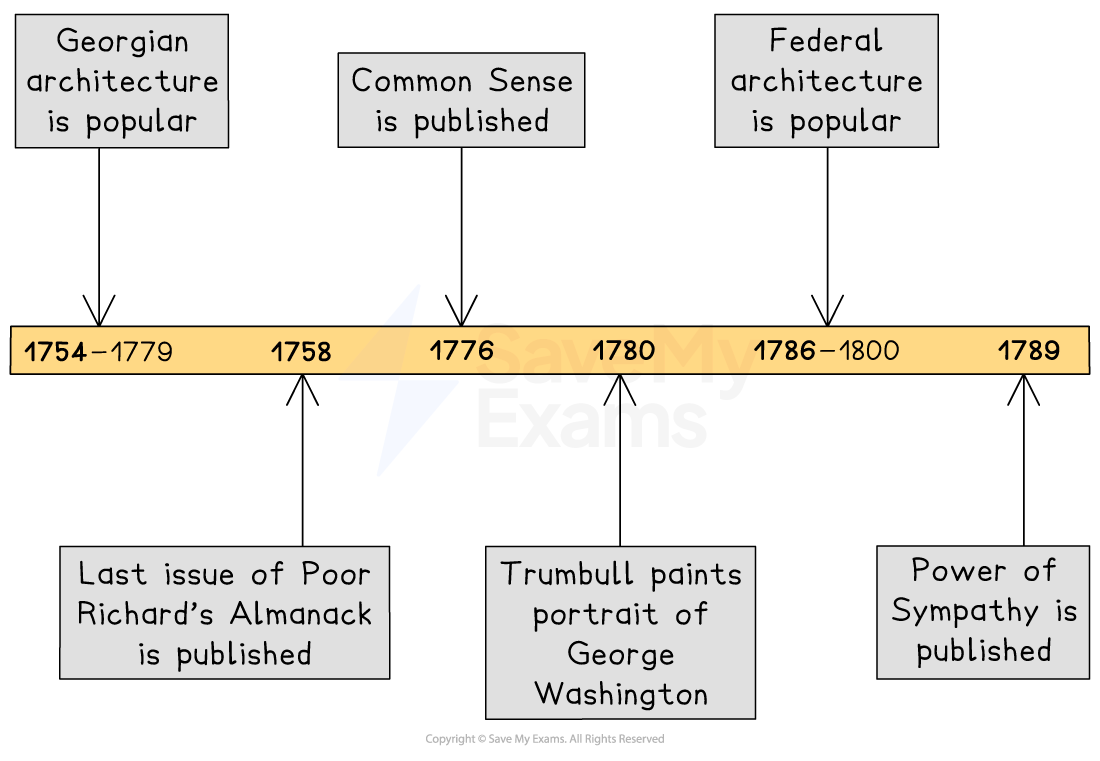An American Identity (College Board AP® US History): Study Guide
Timeline & Summary

War and independence were not the only changes in eastern North America during the second half of the 18th century. Along with a new form of government came new identities and cultural practices based on the ideas and ideals of what it meant to be an American. Some, such as freedom and justice, were shared by all Americans, while others were rooted in regional practices and values.
The arts also transformed alongside the American government.
As Americans distanced themselves from European political traditions, artists and writers found inspiration in their struggle for independence, the leaders who got them there, and the landscape of their new motherland.
Architects emphasized the importance of the country’s new foundations with grand structures and visual references to ancient buildings.
National Culture
A national culture formed as the 13 individual colonies came together to fight British tyranny, and then establish a unified nation
Old European customs were abandoned
State laws and constitutions ended the titled aristocracy
This created a more egalitarian society
Separation of church and state prevented most state governments from providing financial support for religious institutions
New core values developed including:
equality, freedom, and justice
These are all mentioned in the Declaration of Independence
They are also protected by the Bill of Rights
individualism
This is protected by the Bill of Rights
free enterprise
This was demonstrated before the American Revolution when colonists boycotted British imports and instead engaged in independent economic activity such as local businesses creating their own goods
women’s education
Stems from the increasing importance of Republican Motherhood
Regional Culture
Debates over the structure and function of the federal government highlighted the differences between the North and South
Regional culture in the South
Agriculture was the dominant industry
Slavery was widely accepted and the use of enslaved labor was growing
There were fewer cities
The majority of people agreed with Democratic-Republican beliefs
They wanted powerful state governments and a smaller, less powerful central government
Regional culture in the North
Manufacturing was the dominant industry
Slavery was quickly falling out of favor
Some states had banned slavery; others had made plans to gradually phase it out
There were more cities and urban centers
The majority of people agreed with Federalist beliefs
They wanted a strong central government
American Art, Literature, and Architecture
American art
American art was heavily influenced by European styles, Enlightenment ideals, and current events
Before the American Revolution, artists mimicked popular European styles of art, including portraiture
After the revolution, historical narrative paintings became popular
Painter John Trumbull was known for his works depicting important moments during and after the war
Other important artists included Charles Wilson Peale, Gilbert Stuart, and John Singleton Copley
Landscape paintings of the vast American frontier showed the influence of Enlightenment thought
These paintings embodied the Enlightenment’s emphasis on nature
Artwork of all genres highlighted the Enlightenment’s principles of order, harmony, unity, and proportion
As the 18th century went on, artwork began to include women and African Americans as subjects
American literature
American literature was largely educational and/or persuasive. It instructed Americans on:
how they should behave
what they should know
what they should believe
Popular nonfiction topics included Enlightenment philosophy, the first history of the American Revolution, and an almanac of wit and wisdom
Common Sense by Thomas Paine, 1776
History of the Rise, Progress and Termination of the American Revolution by Mercy Otis Warren, 1805
Poor Richard’s Almanack by Benjamin Franklin, yearly, 1732–58
Novels were not yet popular in the United States by the end of the 18th century
The first American novel was The Power of Sympathy by William Hill Brown, 1789
It was a template for future authors to find success in sentimental novels that presented an unrealistic, romantic view of their subject
Popular writing of the mid-to-late 18th century was more descriptive and inclusive of figurative language than the Puritan, religious writings that characterized the first half of the century
American architecture
American architecture was primarily Georgian and Federal, 1754–1800
The Georgian style was popular in the colonies from 1700 to the late 1770s
Examples include Independence Hall in Philadelphia, King’s Chapel in Boston, and buildings in Williamsburg, Virginia
Red brick houses, white wood trim
Interiors were divided by central hallways
Inside walls were covered in wooden panels that were painted in warm colors
The ceilings were white plaster
Federal style was popular from 1785 to 1820
It was influenced by Roman architecture
US leaders believed their new country was similar to Rome’s republic
Federal style featured classical arches with columns and domes
These architectural features gave buildings an air of formality that conveyed their importance
Thomas Jefferson was a big fan of this style
He ensured that the University of Virginia and Washington, DC, were both designed in the Federal style
The US Capitol Building is the largest example of Federal style in the United States
Examiner Tips and Tricks
The Georgian and Federal styles of architecture were popular, from 1754–1800. Here are some easy ways to remember that:
Georgian architecture is named after the King Georges of Great Britain. King George III was on the throne before and during the American Revolution. George Washington was president after the war
Georgian architecture came before Federal architecture, just like King George came before the federal government of the United States
The US federal government was modeled after Rome’s republican government just like Federal architecture was modeled after Roman architecture

Unlock more, it's free!
Did this page help you?